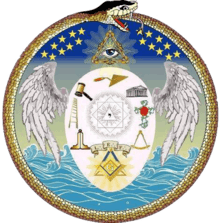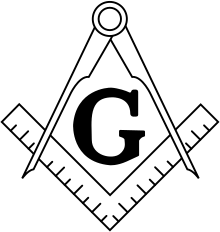Rite of Memphis-Misraim
 | |
| Successor |
|
|---|---|
| Formation | September 1881 |
| Type |
Freemasonry Hermeticism Esotericism |
| Headquarters | Naples (originally) |
| Location |
|
Universal Grand Hierophant |
|
Parent organization |
|
The Ancient and Primitive Rite of Memphis-Misraïm is a masonic rite founded in Naples, Italy in September 1881 by the merger of two older rites; the Rite of Misraïm and the Rite of Memphis. Although founded in 1881, its predecessors have their origins in the 18th century. The system is sometimes known as "Egyptian Freemasonry" due to the invocation of hermetic-derived esoteric symbolism referencing Ancient Egypt in its system of degrees. The rite is noted for its high number of degrees in its system; it has 99 degrees, though some modern French variations practice only 33 degrees.
Memphis-Misraïm was governed internationally under a Grand Hierophant from 1881 until 1923. This first of these was Giuseppe Garibaldi, the famous military leader of the Risorgimento, who had also been Grand Master of the Grand Orient of Italy. After his death, there was factionalism within the organisation, until eventually, the English freemason John Yarker emerged as Grand Hierophant in 1902. He was succeeded by Theodor Reuss in 1913 and upon his death in 1923 there was no longer an international leadership.
The group in France, later renamed the Grande Loge Française du Rite ancien et primitif de Memphis-Misraïm continued to exist, despite the cessassion of activities from the international governance after Reuss' death. Charles Detré (Tedé), Jean Bricaud, Constant Chevillon, Charles-Henry Dupont, Robert Ambelain and Gérard Kloppel were Grand Masters of the French organisation. In particular, Ambelain played a significant role in reforming the rituals of Memphis-Misraïm in 1960. Since then many different people across the world have founded their own organisations claiming descent from the Kloppel lineage.
History
The Rite of Misraïm
From as early as 1738, one can find traces of this Rite filled with alchemical, occult and Egyptian references, with a structure of 90 degrees. Joseph Balsamo, called Cagliostro, a key character of his time, gave the Rite the impulse necessary for its development. Very close to the Grand Master of the Order of the Knights of Malta, Manuel Pinto de Fonseca,[1] Cagliostro founded the Rite of High Egyptian Masonry in 1784. Between 1767 and 1775 he received the Arcana Arcanorum, which are three very high hermetic degrees, from Sir Knight Luigi d’Aquino, the brother of the national Grand Master of Neapolitan Masonry. In 1788, he introduced them into the Rite of Misraïm and gave a patent to this Rite.
It developed quickly in Milan, Genoa and Naples. In 1813, it was introduced by Joseph, Michel and Marc Bédarride. It was forbidden in 1817, following the unease caused by the Carbonari, which intensified in 1820, following the incident of the Four Sergeants of La Rochelle.
The Rite of Memphis
The Rite of Memphis was constituted by Jacques Etienne Marconis de Nègre in 1838, as a variant of the Rite of Misraïm, combining elements from Templarism and chivalry with Egyptian and alchemical mythology. It had at least two lodges (“Osiris” and “Des Philadelphes”) at Paris, two more (“La Bienveillance” and “De Heliopolis”) in Brussels, and a number of English supporters. The Rite gained a certain success among military Lodges. It took on a political dimension and in 1841 it became dormant, probably because of the repression following the armed uprising of Louis Blanqui’s Société des Saisons in 1839. With the overthrow of Louis-Philippe in 1848, the Order was revived on March 5, with its most prominent member being Louis Blanc, a socialist member of the provisional government with responsibility for the National Workshops.
In 1850 Les Sectateurs de Ménès was founded in London which proved popular with refugees fleeing France for London at that time. About ten lodges were set up by French refugees, the most important being La Grand Loge des Philadelphes chartered in London on January 31, 1851, which continued to exist until the late 1870s. During this time it had about 100 members, often called Philadelphes. Between 1853 and 1856 other lodges of the Rite of Memphis were established.[2]
In 1856, Benoît Desquesnes, the exiled secretary of the Société des Ouvriers Typographes de Nord proposed that the higher degrees of the Rite of Memphis were not only superfluous, but undemocratic and inconsistent with the Masonic ideals of equality. Despite the attempts of Jean Philibert Berjeau to dissolve the Philadelphes, they implemented this proposal and elected Edouard Benoît as master. This group became renowned for their involvement in revolutionary politics. However the Gymnosophists and the L'Avenir lodges remained with Berjeau. In 1860 the number of degrees was reduced to 33 in France, The other bodies of the Rite did not agree to this truncation of the degrees, and by 1866 Berjeau dissolved them (in France), most of the Gymnosophists joining the Philadelphes.[3] The Rite of Memphis continued in its 97 degree quality in both the US and South America as well as in other parts of Europe. It must be made clear that no Grand Hierophant of the Rite ever gave up the Rite completely to GOdF or to the US College of Rites. The Rite has been revived all over the World by The Grand Hierophants holding the Original Charters of the Rite through the Ambelain and Kloppel lineages. The Rite is considered Clandestine and Irregular by the Mainstream and UGLE following Grand Lodges, but thrives in Continental Masonry.
The Rite of Memphis-Misraïm
.png)
In 1881, General Giuseppe Garibaldi prepared to fuse the two Rites, to be effective as of 1889. Its popularity was greatly increased owing to the works of German Masonic scholar Theodor Reuss, the agent of John Yarker, who became Deputy Grand Master in 1902 and Grand Master in 1905. Reuss succeeded Yarker in this office in 1913.
Currently, the Rite of Memphis-Misraïm is considered clandestine by lodges affiliated with the United Grand Lodge of England. However, the Grand Orient de France, which heads what is known as Continental Freemasonry (also known as Progressive Universal Freemasonry), has a body which practices the higher degrees in reduced form of the Rite known as the "Grand Ordre Egyptien." The Ancient and Primitive Rite of Memphis - Misraïm has bodies all over the world, even within the United States of America. It is most widely practiced in Europe and Latin America, however, where it is allied with those internationally - recognized bodies that make up Continental Freemasonry.
Regularity
In the USA, the Rite is considered both "clandestine" and "irregular" by mainstream Masonic bodies, because it does not comply with the requirements of appendant bodies. The Rite does not conform to the degree system of standard Masonry, and it permits women to join, whereas mainstream Masonry remains a fraternity, as required by the United Grand Lodge of England.
The Rite is practiced in the USA by a few lineages, including a French-derived lineage traced directly to Robert Ambelain, and operates for both men and women. This last lineage was gathered with Ronald Cappello, a "Regular" Mason who was a member of the Grand College of Rites, as its first National Grand Master. It affiliated members of "Regular" Freemasonry, most notably the members of the Grand College of Rites, such as Arturo de Hoyos and Piers Vaughan, as well as other Masonic rites, and initiated profanes. The group is small compared to most others of the Rite but it continues some work under its current leadership. Its website can be found here: http://www.memphis-misraim.us/. The group is mostly autonomous but ultimately under the control of the International Sovereign Sanctuary based in France.
Prominent members
Some of the most prominent figures in European occultism have been associated with the Rite. This includes the Frenchmen; Gerard Encausse (Papus), Charles Detré (Tedé), Jean Bricaud, Constant Chevillon, Charles-Henry Dupont and Robert Ambelain. The National Grand Master in Germany from 1906 to 1914 was Rudolf Steiner and the founder of the Thule Society, Adam Alfred Rudolf Glauer (Rudolf von Sebottendorf), became an initiate while living in Turkey. The German founder of the Fraternitas Rosicruciana Antiqua, Arnold Krumm-Heller, was also associated. In 1913, Aleister Crowley was the Patriarch Grand Administrar of the Rite. In the United States, Harvey Spencer Lewis was associated with the Rite.
Universal Grand Hierophants
- 1881—1882: Giuseppe Garibaldi
- 1882—1900: Giambattista Pessina
- 1900—1902: Ferdinando Francesco degli Oddi
- 1902—1913: John Yarker
- 1913—1923: Theodor Reuss
Italian Grand Hierophants
- 2009 To Date: Alfredo Marocchino
See also
References
Further reading
- Boris Nicolaevsky, “Secret Societies and the First International,” in The Revolutionary Internationals, 1864–1943, ed. Milored M. Drachkovitch (Stanford, 1966), 36–56.
- Faulks, Philippa and Robert L.D. Cooper. 2008. The Masonic Magician: The Life and Death of Count Cagliostro and His Egyptian Rite. London, Watkins Publishing
- Laos, Nicolas K (2016). Freemasons, World Order, and Mind Wars: The Great Reality of Memphis-Misraim Masonry. Algora Publishing. ISBN 1628942215.
- Prescott, Andrew. The Cause of Humanity: Charles Bradlaugh and Freemasonry

